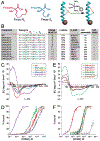Reactivation of the p53 tumor suppressor pathway by a stapled p53 peptide
- PMID: 17284038
- PMCID: PMC6333086
- DOI: 10.1021/ja0693587
Reactivation of the p53 tumor suppressor pathway by a stapled p53 peptide
Erratum in
- J Am Chem Soc. 2007 Apr 25;129(16):5298
Figures



References
Publication types
MeSH terms
Substances
Grants and funding
LinkOut - more resources
Full Text Sources
Other Literature Sources
Research Materials
Miscellaneous

